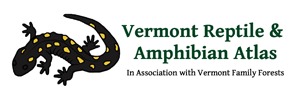Herp Update: October Herping and Lampricides
Herpers,
the widely varying temperatures so far this month have made herp activity hard to predict. On October 14, I received two reports of Eastern Milksnakes. Milksnake is a snake I consider to be a heat lover, yet these reports were not only late in the season but one was from the mountain town of Fayston. Still the temperature that day peaked at about 63° F and it would have been much warmer in a protected and sunny spot.
The next day (October 15), James T reported a Red-bellied Snake out and about in Hyde Park. John J sent the only night-time road search report from last Friday night, October 16th. He reported seeing only one Wood Frog crossing at the site he visited in East Montpelier. As you may remember temperatures were dropping that night. It was 44° F where he was but that is still plenty warm for amphibians to move.
I headed up to Brighton on Saturday morning (October 17th) and was surprised to start running into snow near Lyndon and we had two-inches of snow on the ground in Brighton by noon. Brighton was down to about 1 inch of snow by Sunday afternoon the 18th. On the same afternoon, in the relative warmth of Jericho, Kelly T found and photographed a Ring-necked Snake.
My prediction is that Eastern Red-backed Salamanders and Four-toed Salamanders will be moving both tonight and tomorrow night in the warmer lowland crossing areas if the roads are wet after dark.
Mudpuppies and Lampricides
Despite the Endangered Species Committee’s recommendation not to treat the Lamoille River with lampricides, USFWS plans to treat it on October 27th. When I last communicated, the Aquatic Nuisance Control Permit (a separate permit) that had been drafted for USFWS, had a condition included in it that required USFWS to come up with pre- and post-treatment Mudpuppy population numbers to try to determine if lampricide treatments were having an impact on Mudpuppy populations. Remember that over 520 Mudpuppies were killed in the 2009 treatment of the Lamoille River. However, USFWS responded that if they were required to do a population study, they would not treat the Lamoille River. So the Agency of Natural Resources (ANR) removed that provision and is allowing USFWS to use lampricides without gathering any Mudpuppy population data.
Meanwhile, Ira Powsner has been leading an effort to raise public awareness about the impacts of lampricides on non-target organisms, particularly the Mudpuppy. He gathered over 600 signatures on a petition that was sent to ANR Secretary Julie Moore and he later met with her in person (way to go Ira!). Ira was disappointed that no Mudpuppy population study was required in the final permit, so he decided to organize a polite and informed public demonstration at the treatment site on the day of the treatment (October 27th). He is creating a banner that says “Where is the Data?” and he will be reaching out to the press mid-week. He would like to get about 20-30 people to join him. If you are interested, contact Ira directly at irapowsnerpaintingandprojects@gmail.com for specifics.
To their credit, Steve Parren and Mark Ferguson of Vermont Fish and Wildlife have organized a group of volunteers that will be on the water during and immediately after the treatment to catch and remove stunned Mudpuppies, get them into untreated water to hopefully revive them, and then later move them above the dam in an area that is not treated. They currently have all the people they need for this night-time effort.
Jim

